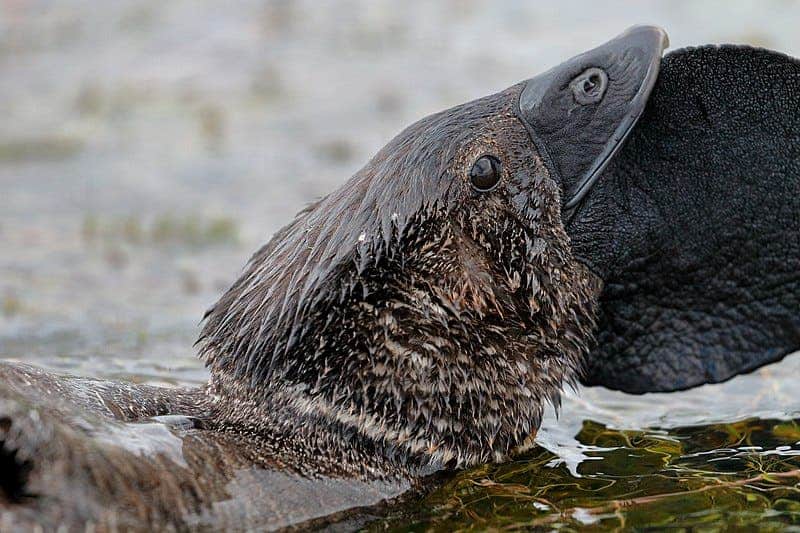
When biologist Carel ten Cate heard rumors of a talking duck in Australia, he brushed it off like a comical anecdote, like any sane human being. But his curiosity got the better of him, so he tracked down a well-respected Australian scientist who first noticed this phenomenon more than three decades ago.
After listening to verified footage showing an adult musk duck vocalizing the sounds of a door slamming or squeaking, a pony snorting, a man coughing, and even the all too familiar slur “You bloody fool!”, the Dutch biologist was simply stunned. Listen for yourself.
One of nature’s best impersonator
The biologist’s encounter with this articulate duck led him down a rabbit hole in which he found more evidence that musk ducks (Biziura lobata) can mimic sounds from nature, as well as those made by humans.
This extraordinary ability, which was documented in the journal Philosophical Transactions of the Royal Society of London B, grants the musk duck access to an exclusive club of animals that are capable of acquiring vocalization through learning. These include parrots, hummingbirds, and some songbirds, as well as some whales, seals, dolphins, and bats on the mammalian front.
“These sounds have been described before, but were never analyzed in any detail and went so far unnoticed by researchers of vocal learning,” said ten Cate, who is a professor of animal behavior at Leiden University. His co-author is Australian scientist Peter J. Fullager, who first documented a musk duck imitating sounds over 30 years ago.
Nearly all mammals produce some vocal sounds, from dogs barking and howling to cattle lowing and mooing. Humans are very different in that they can string together sounds that have particular meanings, which we call words, allowing us to communicate with one another through language.
But at the same time, while most mammals are born with innate vocalization abilities, humans are not.
We all need to learn how to speak and the brain processes that support this type of learning are still poorly understood. This is why studies such as this that probe acquired vocalization in other species are important for unraveling these processes.
Vocal learning refers to imitating sounds or producing completely new vocalizations, depending on the species involved. Central to this ability seems to be auditory feedback during development.
Most species have a more innate ability to learn how to make sounds. But a few rare animals, including a handful of mammals and, of course, human beings, are vocal learners. They need auditory feedback to learn how to make the right sounds if they want to communicate,” said Michael Yartsev, assistant professor of bioengineering at the University of California, Berkeley, in a 2020 interview with the Dana Foundation.
Yartsev’s earlier studies with Egyptian fruit bats showed that individuals that have been isolated or exposed to unique acoustic environments right after they were born had different vocalizations than groups of bats that were raised normally.
“This suggests that their vocalizations have some plasticity. Our own work has shown that, even in adults, if you expose the bats to sound perturbation, they have the capacity to modify or adapt their vocalizations in a stable manner over prolonged periods of time. So, there are good indications that there is some form of plasticity there that we can investigate,” Yartsev said.
The musk ducks seem to be this way too. Besides the musk duck that imitated his former caretaker’s insults, ten Cate identified another musk duck that was raised alongside Pacific black ducks (Anas superciliosa), and consequently quacked like them. Both ducks were raised in captivity since they were hatchlings.
Wild musk ducks sound very different and they do not care to acquire new sounds in their vocal repertoire, which also explains why their vocalization acquisition abilities have been overlooked until now. They allegedly make for horrible pets.
Furthermore, not all captive musk ducks seem to imitate non-native sounds. Captive female musk ducks don’t perform vocal displays, and the imitations performed by the males were part of their advertising displays to potential mates.
“Together with earlier observations of vocal differences between populations and deviant vocalizations in captive-reared individuals, these observations demonstrate the presence of advanced vocal learning at a level comparable to that of songbirds and parrots. We discuss the rearing conditions that may have given rise to the imitations and suggest that the structure of the duck vocalizations indicates a quite sophisticated and flexible control over the vocal production mechanism,” the scientists wrote in their new study.
Ducks split off from the evolutionary family tree sooner than other birds, such as parrots and songbirds. What’s more, duck brains differ quite a lot structure-wise from their avian relatives. Therefore, the “observations support the hypothesis that vocal learning in birds evolved in several groups independently rather than evolving once with several losses,” the researchers concluded.


